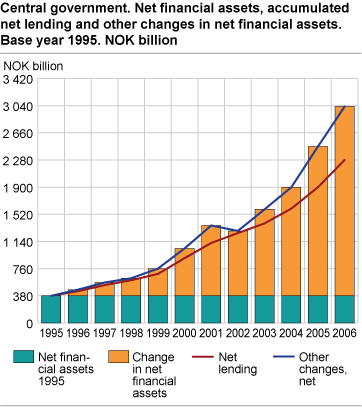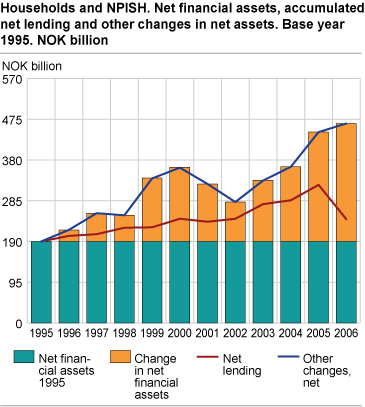Content
Published:
This is an archived release.
Government financial wealth rose NOK 2 600 billion
The financial accounts for central government show that net financial assets have increased from NOK 380 billion in 1995 to NOK 3 027 billion in 2006. Investments of oil revenues in the Government Pension Fund - Global and an increase in the value of the government’s holdings in domestic enterprises are two of the main factors behind this development.
The annual financial accounts for institutional sectors indicate that the central government, households and NPISHs had net financial assets at the end of 2006, while local government and non-financial corporations were in a net debt position. Non-financial corporations are most indebted, but this is due to high investments in non-financial assets.
Increase in value of government owner shares
Central governments net financial assets towards domestic sectors have increased from NOK 451 billion at the end of 1995 to NOK 1306 billion at the end of 2006. A substantial part of this growth is a result of increased value of holdings in enterprises owned by central government. Between 2000 and 2006, several public enterprises were listed on the stock exchange and the listing has made the fair value of the enterprises visible. In theory, all shares are to be treated at market value, but experience shows that this principle is only used for quoted shares. Two of the largest government-owned enterprises, Telenor and Statoil, were listed on the stock exchange in 2000 and 2001 respectively. At the time of quotation, the value of government owner shares in Telenor and Statoil increased by NOK 50 and NOK 118 billion respectively. The rise in share prices of quoted shares owned by central government has also contributed to the increase in the value of owner shares. Overall, other changes in assets (net holding gains, stock exchange quotation etc.) contributed NOK 627 billion to the change in net financial assets towards domestic sectors by NOK 855 billion in the period.
The central government financial standing is to a high degree dominated by the Government Pension Fund - Global. The majority of the government’s income from oil and gas exploitation in the eleven-year period has been transferred to the fund and the fund’s foreign investments have contributed substantially to the central government net lending. Between 1995 and 2006, central government accumulated financial transaction abroad amounted to NOK 1 672 billion. Net financial assets towards the rest of the world have increased from NOK -71 billion at the end of 1995 to NOK 1 721 billion at the end of 2006. This represents a change in net financial assets of NOK 1 792 billion.
Holding gains have contributed to household net financial wealth
Household net financial assets have increased by NOK 275 billion during the period. A substantial part of the appreciation can be explained by net holding gains from quoted securities. In particular, the development in the securities market over the last two-year period has contributed to an increase in the value of net financial assets, but NOK 22 billion of the total increase of NOK 242 billion in the eleven-year period is due to new and improved security statistics, which were introduced for the first time in 2006
Household debt mainly comprises loans borrowed from financial corporations. Borrowing grew rapidly at the beginning of the period, but the growth rate has stabilised gradually on a high level and the borrowing has had a considerable effect on net lending. However, from 2002 onwards, reinvested share dividends in unquoted enterprises have contributed to keeping up the level of acquisition of financial assets, but on 1 January 2006 dividend tax for private shareholders was introduced. As a result, financial investments have dropped, and household and NPISH net lending has fallen.
| 1995 | 2006 | ||||||||||||||||||||||||||||||||||||||
|---|---|---|---|---|---|---|---|---|---|---|---|---|---|---|---|---|---|---|---|---|---|---|---|---|---|---|---|---|---|---|---|---|---|---|---|---|---|---|---|
| Net financial assets | Financial assets | Liability | Net financial assets | Financial assets | Liability | ||||||||||||||||||||||||||||||||||
| Non-financial corporations | -659 | 967 | 1 626 | -2 163 | 3 447 | 5 610 | |||||||||||||||||||||||||||||||||
| Financial corporations | 86 | 1 701 | 1 615 | 132 | 5 346 | 5 214 | |||||||||||||||||||||||||||||||||
| Central government | 380 | 731 | 351 | 3 027 | 4 248 | 1 221 | |||||||||||||||||||||||||||||||||
| Local government | -41 | 98 | 139 | -51 | 262 | 313 | |||||||||||||||||||||||||||||||||
| Households and NPISH | 190 | 836 | 647 | 465 | 2 226 | 1 761 | |||||||||||||||||||||||||||||||||
| Domestic sectors, consolidated | -44 | 478 | 522 | 1 410 | 5 126 | 3 716 | |||||||||||||||||||||||||||||||||
| Rest of the world | 44 | 522 | 478 | -1 410 | 3 716 | 5 126 | |||||||||||||||||||||||||||||||||
Reinvested dividendsDividend tax for private shareholders was introduced on 1 January 2006. The tax reform initiated huge tax-motivated transactions which have dominated the main pictures in the financial accounts for households and non-profit institutions serving households, especially from 2002. Until the end of 2005, private owners withdrew extraordinarily high dividends with the intention of relocating acquired equity (object for taxation according to new tax rules), inter alia in the form of investments in shares (paid in equity) and loans to unlisted enterprises. After the new tax regime took effect, the payment of extraordinarily high dividends has come to an end. From 2006 onwards, share capital and share premium accounts have been redeemed and paid out to private owners as an alternative to dividends. We have assumed that shareholders have taken out a substantial part of the share capital that was previously ploughed back into the business. Estimates for reinvested dividends and redeemed share capital are incorporated in the financial accounts. The estimates are based on accounting statistics for limited companies, tax return account statistics and share statistics (see ssb.no). The treatment of unquoted shares in the financial accounts is affected by the general lack of precise information. This leads to significant uncertainty in the computation of transactions and stocks of shares in the financial accounts. |
Concepts etc.Annual financial accountsAccording to the EEA Agreement Norway is obliged to report annual financial accounts to Eurostat. The data submitted to Eurostat are taken from the database for quarterly financial accounts, FINSE. The report forms the basis for the release of annual figures. Financial accounts are based on a list of different statistical sources and among these are accounting statistics for financial corporations and general government. The financial accounts differ from the accounting statistics due to the incorporation of market values in financial accounts and the compilation process in FINSE, which comprises several reconciliation procedures and consistency checks that may change the source statistics. Statistical discrepancies between financial and non-financial accountsThe link between non-financial and financial accounts is represented by the balancing item “net lending/net borrowing”. In theory, net lending derived from non-financial accounts should be identical to net lending derived from financial accounts. However, experience shows that there are significant discrepancies between the two parts of the accounting system. Net lending is a marginal balancing item which is calculated on the basis of large aggregates. Even relatively small errors in these aggregates may cause significant discrepancies in net lending. The observed discrepancies are caused by flaws and shortcomings in both sets of accounts. Among other factors this is due to lack of information, which has to be replaced by estimates. Examples of the problem addressed in the financial accounts are unquoted shares together with households and NPISH claims towards the rest of the world and non-financial corporations. DefinitionsA . Non - financial account / National accounts , institutional sectors . Net lending = saving + net capital transfers - net acquisition of non - financial assets Disposable income may be used either for finale consumption or savings. Savings can be invested in financial or non-financial assets. B . Financial accounts Net lending = net acquisition of financial assets - net incurrence of liabilities If savings exceed non-financial investments, a sector has surplus of funds and becomes a net lender to other sectors. In the financial transaction account, this means that the sector acquire more financial assets than liabilities. On the other hand, if savings are less than non-financial investments, investments have to be funded either by selling financial assets or incurring debts. Household investments in non-financial assets mainly reflect the purchase of new housing and fixed investments by unincorporated enterprises. They typically finance substantial parts of these investments by incurring debt in the form of loans. Net financial assets ( net financial wealth ) = total financial assets - total liabilities The financial balance sheet shows the financial position of a sector at the end of the reference period and is broken down into categories of financial assets and liabilities. Insurance technical reserves, currency and deposits are the predominant assets held by households, while loans provided by financial corporations (banks etc) constitute the main proportion of liabilities. Changes in net financial asset = net lending + other change in assets , net The change in the financial balance sheet during the reference period is a result of accumulated financial transactions and other changes in assets. The latter category mainly reflects revaluations due to changes in market prices of financial instruments. |
Contact
-
Statistics Norway's Information Centre
E-mail: informasjon@ssb.no
tel.: (+47) 21 09 46 42


